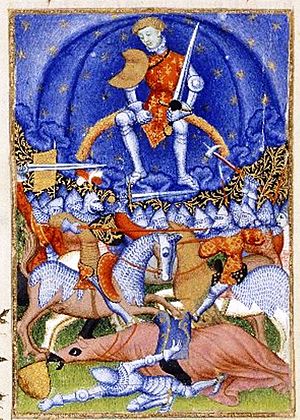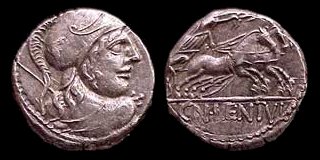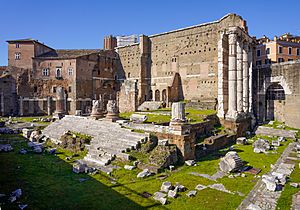Mars (mythology) facts for kids
Quick facts for kids Mars |
|
|---|---|
| God of war, guardian of agriculture and the Roman people | |
| Member of the Dii Consentes | |

Statue of Mars from the Forum of Nerva, 2nd century CE
|
|
| Other names | Mavors, Mavorte (archaic, poetic) |
| Planet | Mars |
| Symbols | spear, shield |
| Day | Tuesday (dies Martis) |
| Festivals | February 27, March 14 Equirria horse races March 1 Dies natalis (birthday) and feriae of the Salian priests March 17 Agonia May 14 dies natalis, Temple of Mars Invictus October 15 October Horse sacrifice October 19 Armilustrium |
| Personal information | |
| Consort | Nerio and others including Rhea Silvia, Venus, Bellona |
| Children | Cupid |
| Parents | Jupiter and Juno |
| Siblings | Vulcan, Minerva, Hercules, Bellona, Apollo, Diana, Bacchus, etc. |
| Greek equivalent | Ares |
| Norse equivalent | Tyr |
| Etruscan equivalent | Maris, Laran |
In ancient Rome, Mars was a very important god. He was known as the god of war. He was also seen as a protector of farming and the Roman people. Mars was the son of Jupiter, the king of the gods, and Juno, the queen.
Many festivals for Mars were held in March. This month is actually named after him! Other festivals took place in October. These months were important because they marked the start and end of both military campaigns and farming seasons.
The Romans connected Mars with the Greek god Ares. But Mars was different from Ares. Ares was often seen as wild and destructive. Mars, however, represented military strength used to bring peace. He was also considered a father figure to the Roman people.
Contents
The Birth of Mars
Like the Greek god Ares, Mars was usually thought to be the son of Jupiter and Juno. However, some stories say that Juno had Mars all by herself.
In the very first Roman calendar, March was the first month of the year. So, Mars was like a god born with the new year.
Mars's Partners
Mars had a partner named Nerio. Her name meant "Valor" or "Courage." She showed the strength and power of Mars. Her name was linked to the idea of "manly virtue."
Venus and Mars
The story of Mars and Venus, the goddess of love, was very popular. Poets and artists loved this pair. They were often shown together in Roman art.
Sometimes, pictures of Venus and Mars suggested they were married. This couple was often used in art to show a passionate relationship between a husband and wife. In art, Mars was sometimes shown without his weapons. He might even be sleeping or relaxed.
Animals Sacred to Mars

Two wild animals were especially sacred to Mars: the woodpecker and the wolf. Romans believed these animals often lived in the same hills and forests.
The woodpecker was sacred to Mars because it was seen as brave. It had a strong beak that could peck through trees. People even carried parts of a woodpecker's beak as a lucky charm. They believed it could protect them from bee stings and leech bites. The woodpecker was very important in Roman augury. This was a practice where priests tried to understand the gods' will by watching birds.
Mars's connection to the wolf is famous from the story of Romulus and Remus. These twin brothers were the sons of Mars. They were left to die as babies. But a she-wolf found them and nursed them. The woodpecker also helped bring them food. This story shows how important the wolf was to Mars.
In Roman art, the wolf often appeared as Mars's animal. There was even a statue group showing Mars with wolves. The appearance of a wolf was sometimes a sign of Roman victory in battle.
In Roman Gaul (an area that is now France), the goose was also linked to Mars. Archaeologists have found geese buried with warriors. Geese were thought to be aggressive animals.
Temples in Rome
The earliest place where Mars was worshipped in Rome was the Altar of Mars. This altar was in the Campus Martius, which means "Field of Mars." This area was outside the city's sacred boundary.
The main Temple of Mars was also outside the city. It was built to honor Mars as a warrior god. Soldiers sometimes gathered at this temple before going to war. It was also the starting point for a big parade of Roman cavalry every year.
Another temple to Mars was built in the Circus Flaminius. This temple had huge statues of Mars and Venus.
How Mars Was Pictured

In Roman art, Mars was shown in different ways. Sometimes he had a beard and looked older. Other times, he was young and clean-shaven. He often wore a helmet or carried a spear. These showed he was a warrior. Mars was one of the first gods to appear on Roman coins.
Mars's Spear
The spear was Mars's special tool. Just like Jupiter had his lightning bolt, Mars had his spear. When Mars was shown as a god who brought peace, his spear was decorated with leaves. This could be seen on altars or coins.
Festivals and Celebrations
Mars had many festivals, especially in March, the month named after him. Some were also in October. These months were important for both war and farming. Many festivals with horse races happened in the Campus Martius. Some March festivals were like new year celebrations.

Here are some of Mars's festivals:
- February 27: Equirria, a day for chariot or horse races.
- March 1: Mars's "birthday." This day was also special for his mother, Juno.
- March 14: Another Equirria with more chariot races.
- March 14 or 15: Mamuralia, a new year festival. An old figure, perhaps representing the "old Mars," was driven out.
- March 17: An Agonalia, a special type of religious event.
- March 23: Tubilustrium, a purification ceremony for the army before they went to war.
- October 15: The October Horse ritual. This included a chariot race and a horse sacrifice.
- October 19: Armilustrium, which meant "purification of arms." This was a ceremony to clean the soldiers' weapons.
Mars was also honored at other festivals like the Robigalia and Consualia. From 217 BCE, Mars was one of the gods honored at a special banquet called a lectisternium.
Ancient Roman songs for gods are rare. But Mars was mentioned in two. The Arval Brothers, a group of priests, sang a hymn to Mars while dancing. The Carmen Saliare was sung by Mars's priests, the Salii. They sang it while carrying twelve sacred shields through the city. The language of this hymn was so old that people in the 1st century AD could barely understand it.
Mars on the Calendar
Mars gave his name to the third month of the Roman calendar, Martius. This is where the English word "March" comes from. In the oldest Roman calendar, March was the first month.
The planet Mars was also named after him. In some old writings, the planet and the god were thought to share qualities. In many languages, Tuesday is named after Mars or the god of war. For example, in Latin, it was martis dies ("Mars's Day"). This became mardi in French and martedì in Italian. The English word "Tuesday" comes from "Tiw's Day," named after the Norse god of war, Tiw (or Týr).
Images for kids
-
A relief depicting Mars and Venus on a black-slip bowl from Campania, Italy, 250–150 BCE, British Museum
-
She-wolf and twins Romulus and Remus from an altar to Venus and Mars
-
Denarius, issued 88 BCE, depicting the helmeted head of Mars, with Victory driving a two-horse chariot (biga) on the reverse
-
The so-called Mars of Todi, an Etruscan bronze of the early 4th century BCE, probably depicting a warrior
-
Mars celebrated as peace-bringer on a Roman coin issued by Aemilianus
-
A statue to Mars Ultor from Balmuildy on the Antonine Wall has been scanned and a video produced.
-
Fragmentary dedication stele to Mars Augustus from Roman Gaul
See also
 In Spanish: Marte (mitología) para niños
In Spanish: Marte (mitología) para niños












